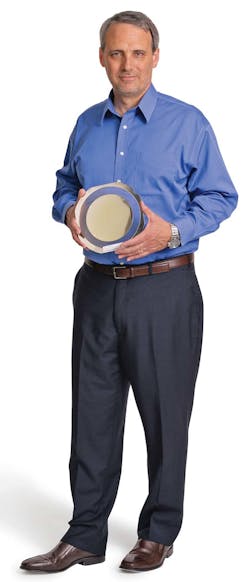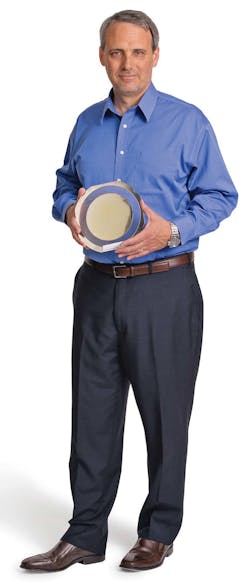Interview: James Klein, Vice President of Infrastructure & Defense Products, TriQuint
This file type includes high resolution graphics and schematics when applicable.
JD: Given the recently announced merger of TriQuint and RFMD, what main technological capabilities would you say the two companies offer each other?
JK: Both TriQuint and RFMD have a long heritage as leaders in the RF solutions space. We look forward to merging TriQuint’s advanced filter expertise and semiconductor capabilities with RFMD’s strong background in semiconductors and internal packaging capabilities to create a market leader in products based on gallium-arsenide (GaAs), gallium-nitride (GaN), and CMOS technology.
Related Articles
• Interview: Suja Ramnath, MACOM
• Interview: Amir Eliaz, Co-Founder and CTO, MagnaCom
• Interview: Hatem Zeine, Ossia, Inc.
By joining together, TriQuint and RFMD will consolidate their complementary capabilities to create a $2-billion RF powerhouse that offers a broad portfolio of enabling technologies with proven expertise in high-volume manufacturing. We’ll be able to develop and commercialize tightly integrated solutions at record speeds for the world’s top communications, defense, and aerospace companies.
JD: How will the R&D capabilities of the two companies benefit from the merger?
JK: One of the reasons the merger is advantageous to both companies is that there isn’t a significant amount of overlap between TriQuint and RFMD in terms of our technology portfolios. This results in a much broader portfolio of technologies that will create value for our customers. It also provides the opportunity to enter into broader growth markets both today and in the future.
JK: By bringing the capabilities of TriQuint and RFMD together, we’re creating a new industry leader that can accelerate GaN technological development and more quickly deliver innovative products to the marketplace. The new combined company will expand its leadership in the GaN market beyond defense applications into infrastructure to drive widespread global adoption.
JD: Are there new goals/roadmaps for the GaN market based on this merger?
JK: It’s really too early to provide a lot of details. We’re diving much deeper now into detailed assessments of the respective capabilities of both companies. We’ll align product and technology roadmaps to determine the best way to solve our customers’ RF challenges and quickly realize the strategic benefits of the merger. If anything, the merger will strengthen our resolve around GaN and allow us to more quickly accelerate our technologies into broader markets.
JD: How will the combined company’s aerospace and defense capabilities be enhanced?
JK: We have a long history of supporting defense technology and infrastructure development, and this merger reinforces our focus within that industry. For example, TriQuint has been a leading supplier of semiconductor technologies for military radar systems used on fast jets including the F-15, F-22, and F-35. We hold U.S. Department of Defense (DoD) Trusted Source accreditation. RFMD also is active in the defense space with products targeting radar, communications, and electronic-warfare applications. The merger will broaden our collective capabilities, and we plan on bringing all those new products to our defense customers.
JD: How will TriQuint's fab be used to enhance the combined business?
JK: Both TriQuint and RFMD have world-class fab capabilities. With its advanced technology portfolio, we expect the new company to enable the highest-performing, smallest, and most cost-effective RF products on the market. Over the next 24 months, we will be going through a process to streamline our efforts and fully rationalize our capacity needs.
JD: What impact do you predict the merger will have on mobile-device and network-infrastructure technology?
JK: With TriQuint’s filtering capability and RFMD’s advanced packaging and CMOS technology—coupled with our GaN and GaAs—we plan to deliver the industry’s most comprehensive portfolio of critical RF technologies to mobile and infrastructure customers. We will leverage our collective integration expertise to pack more functionality and higher performance into single modules that are considerable smaller than discrete solutions. In addition, we will continue to drive innovation at the heart of the mobile data ecosystem and enable the worldwide transition to Long Term Evolution (LTE)—from base stations and optical fiber networks to highly integrated RF modules for today’s increasingly complex mobile devices.
This file type includes high resolution graphics and schematics when applicable.
Mobile Ramifications
This file type includes high resolution graphics and schematics when applicable.
In the mobile-device space, the LTE buildout is expanding RF band counts in handsets dramatically. This trend, in turn, is driving increased demand for broadband power amplifiers (PAs) and high-performance filters. This has created a strong push toward integrated modules, which combine premium filters with highly efficient broadband PAs to reduce RF size and complexity for smartphones and other mobile devices. The company will be uniquely positioned with the technologies, integration know-how, and high-volume manufacturing expertise to address our customers’ toughest LTE system and chipset challenges.
Mobile carriers also are easing the strain on their overstretched networks by offloading an increasing amount of data traffic onto WiFi and small-cell networks, such as micro-, pico-, and femtocells. Our advanced filters and GaN and GaAs amplifiers enable these solutions to handle the interference, range, and capacity demands that we anticipate, as the utilization of high-bandwidth applications and crowded spectrum become more prevalent for consumers and businesses alike.
Related Articles
• Interview: Suja Ramnath, MACOM
• nterview: Amir Eliaz, Co-Founder and CTO, MagnaCom
• Interview: Hatem Zeine, Ossia, Inc.
JD: How will the merger disrupt/enable technologies in the aerospace/defense industry?
JK: We’ll be able to offer our long-time global customers a broader set of technologies that will continue our legacy of outstanding service and support. We remain committed to the defense market as a driver of innovative new technologies.
JD: What industries will become more accessible due to the merger?
JK: One of the great aspects of this merger is the limited amount of overlap in the markets we serve. RFMD has strong capabilities in cable television and WiFi, while TriQuint brings defense-industry knowledge and products as well as our proven optical and base-station technologies. It is really an ideal union and will quickly create a number of growth opportunities in three large, global markets: mobile devices, network infrastructure, and aerospace/defense.
We are in the very early stages of a deliberate strategic process to analyze our business and unleash our collective potential. As we have stated, however, we believe that there is at least $150 million in synergies that we can bring to bear as this process takes place over the next 24 months.
This file type includes high resolution graphics and schematics when applicable.
About the Author
Jean-Jacques DeLisle
Jean-Jacques graduated from the Rochester Institute of Technology, where he completed his Master of Science in Electrical Engineering. In his studies, Jean-Jacques focused on Control Systems Design, Mixed-Signal IC Design, and RF Design. His research focus was in smart-sensor platform design for RF connector applications for the telecommunications industry. During his research, Jean-Jacques developed a passion for the field of RF/microwaves and expanded his knowledge by doing R&D for the telecommunications industry.



